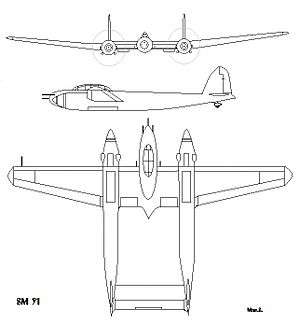Savoia-Marchetti SM.91
| SM.91 | |
|---|---|
 | |
| Role | Fighter-bomber |
| Manufacturer | Savoia-Marchetti |
| First flight | 11 March 1943 |
| Number built | 2 |
|
| |
Savoia-Marchetti first developed the SM.91, a long-range fighter-bomber, to compete in a contract offered by the Regia Aeronautica to the Italian aircraft companies in 1938.
Design and development
In July 1942, the Regia Aeronautica requested designs for a new aircraft, propelled by the DB605 engine, capable of flying at 620 km/h (385 mph) with a range of 1,600 km (990 mi). The armament should consist of six MG 151 cannons in the nose and wings and a 12.7 mm Breda-SAFAT machine gun as a defensive weapon. It should have an 800 kg (1,800 lb) bomb load. At that point, the request for a long-range fighter killed the SM.88, still in development, and the SM.91, a larger, heavier and more modern design, was authorized.
The fuselage and the wings were all-metal, to achieve the best performance regardless of cost. The central nacelle held the crew of two, and the wings and tail were similar to the SM.88. Fuel capacity was 1,600 l, but with auxiliary tanks could be raised to 1,800 l. It is unknown if it was capable of a range of 1,600 km (990 mi).
The two DB 605 engines gave a total of 2,950 hp. The aircraft's maximum speed at 585 km/h (363 mph) was better than the SM.88. There were three 20 mm MG 151s in the nose. Two more were mounted in the wings, close to the fuselage. Another machine gun was provided for the rear gunner. Total bomb load was 1,640 kg (3,620 lb) or a torpedo.
The prototype, designated MM.530, flew for the first time on 11 March 1943, tested by Aldo Moggi. There were two prototypes, the second a modified SM.88 prototype.
The machine flew at Vergiate and logged 27 hours in the next few months. It was advanced, but was not entered into the official tests at Guidonia, perhaps because it was still undergoing testing. The first prototype was captured and sent to Germany in October 1943, after which it vanished and is presumed destroyed. The second prototype was captured by the Germans incomplete when they occupied northern Italy in September 1943. This aircraft was tested on 10 July 1944, but was destroyed by Allied bombers later in the year.
Specifications (SM.91)

General characteristics
- Crew: 2, pilot and rear gunner
- Length: 13.25 m (43 ft 6 in)
- Wingspan: 19.7 m (64 ft 7 in)
- Height: 3.85 m (12 ft 7 in)
- Wing area: 41.76 m² (449.3 ft²)
- Empty weight: 6,400 kg (14,080 lb)
- Powerplant: 2 × Daimler-Benz DB 605 liquid-cooled supercharged inverted V12 engines, () each
Performance
- Maximum speed: 585 km/h (315 kn, 363 mph)
- Range: 1,600 km (864 nmi, 995 mi)
- Service ceiling: 10,800 m (35,425 ft)
- Climb to 6,000 m (19,680 ft): 7 min. 40 sec.
Armament
- 5 × 20 mm MG 151 cannons
- 1,640 kg bombload
See also
- Related lists
References
- Lembo, Daniele, I bifusoliera della Regia, Storia militare magazine, Westward editions, n.11, April–May 2000 (Italian)
External links
| Wikimedia Commons has media related to Savoia-Marchetti. |
